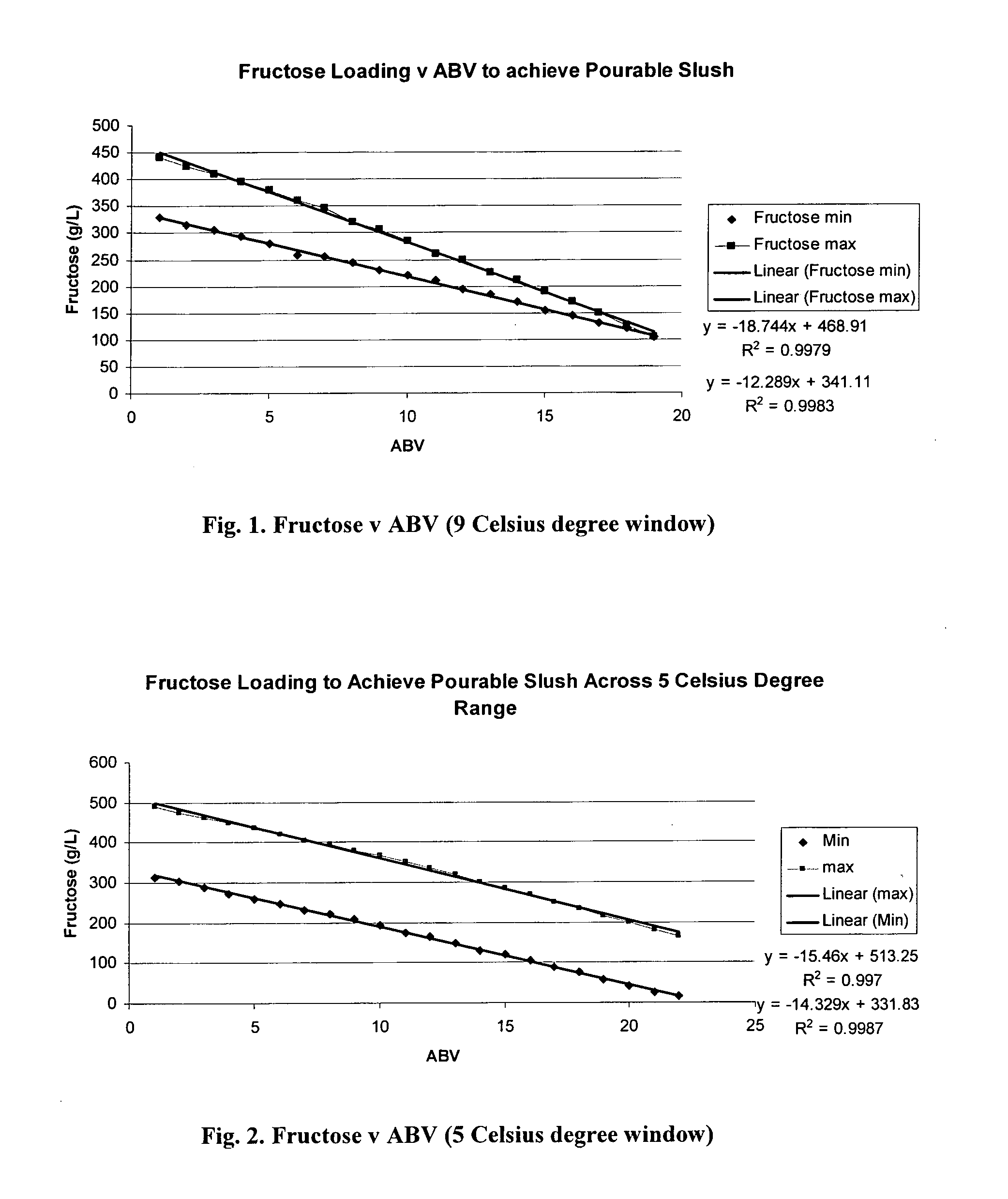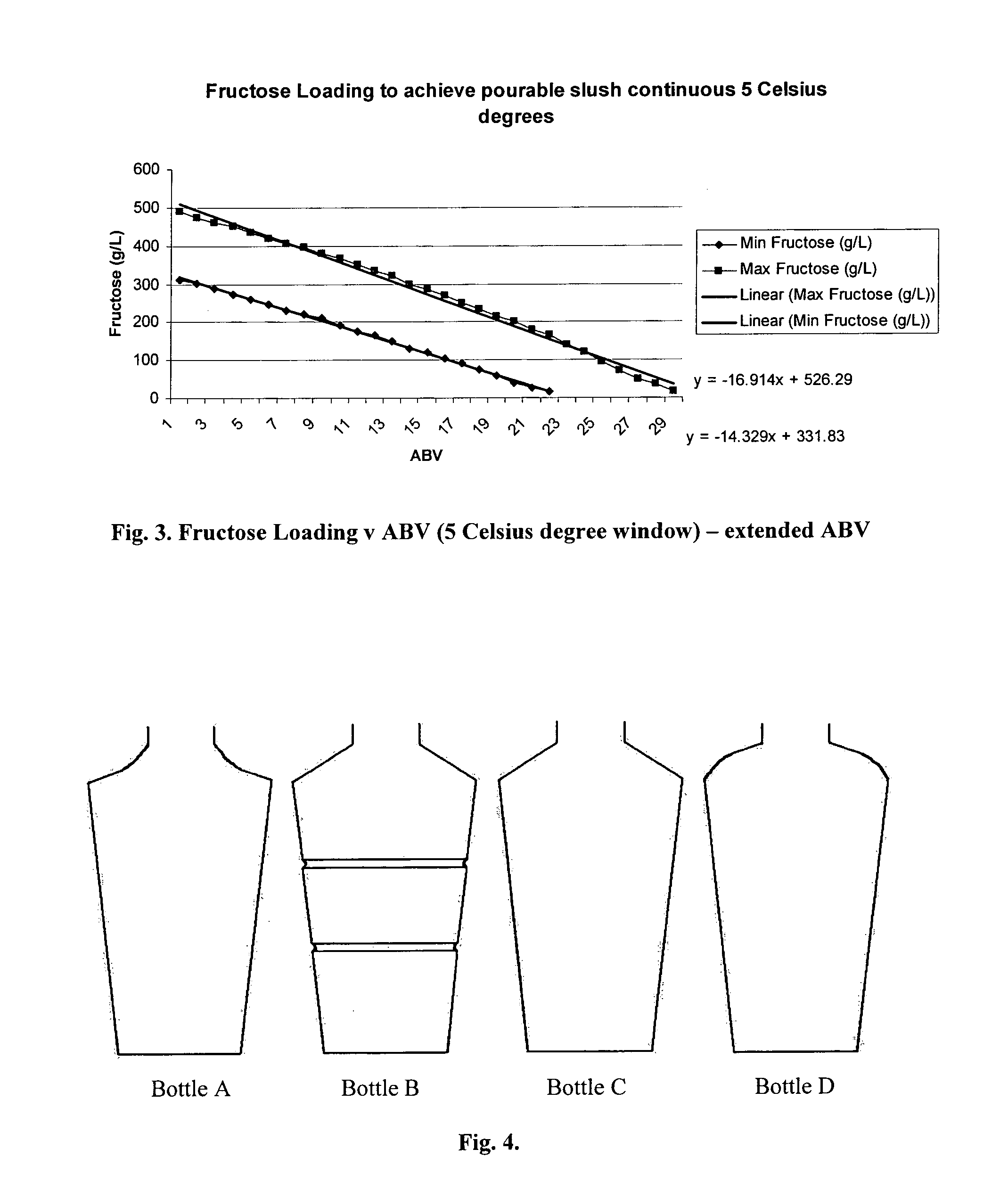Slush
a technology of slush and ice, which is applied in the field of slush, can solve the problems of affecting the taste of cold beverages, the variability of all products, and the inability to meet the needs of consumers, and achieves the effects of convenient preparation, reliable and consistent reproducibility, and simple preparation for consumers
- Summary
- Abstract
- Description
- Claims
- Application Information
AI Technical Summary
Benefits of technology
Problems solved by technology
Method used
Image
Examples
example 1
[0042]It was found, at a specific ABV, that particular minimum and maximum amounts of fructose resulted in pourable slushes, as indicated in Table 1-1.
TABLE 1-1Min g / L fructose addedMax g / L fructose addedto achieve pourableto achieve pourableABVslush at −20° C.slush at −11° C. 1 Fructose1330440 2 Fructose2315425 3 Fructose3305410 4 Fructose4293395 5 Fructose5280380 6 Fructose6258360 7 Fructose7255345 8 Fructose8245320 9 Fructose923030510 Fructose1022028511 Fructose1121026012 Fructose1219524813 Fructose1318522514 Fructose1417021015 Fructose1515519016 Fructose1614517017 Fructose1713015018 Fructose1812012519 Fructose19105105
[0043]The slush product, made with a fructose content as defined in Table 1-1, is pourable across the entire temperature range from −11 to −20° C.
[0044]Therefore, according to the data in Table 1-1, the range of fructose contents needed to be added to, for example, a 9% ABV beverage formulation is 230 to 305 g / L, to result in a beverage with a minimum amount of ice ...
example 2
[0063]A similar set of data was generated as for Example 1, except with glucose substituted for fructose, but otherwise similarly resulting in a pourable slush at the extremes of freezer temperature, −11 and −20° C. These results are set out in Table 2-1 below.
TABLE 2-1Min g / L glucoseMax g / L glucoseadded to achieveadded to achievepourable slushpourable slushABVat −20° C.at −11° C.1Glucose14355302Glucose24205003Glucose34054804Glucose43904605Glucose53754356Glucose63504107Glucose73403908Glucose83203659Glucose930534010Glucose1028031511Glucose1126529012Glucose1224526513Glucose1323024014Glucose1421021515Glucose15195195
[0064]The amount of glucose required to achieve comparable levels of pourability follows a similar trend to that for fructose, but a higher loading of glucose is necessary.
[0065]It is possible to generate the following prediction formulas from plots of glucose content against ABV, as in Example 1:
ylower=−17.5x+457.7 and yupper=−24.0x+553.7,
where y=glucose content (g / L) and x...
example 3
[0070]A similar set of data was generated as for Examples 1 and 2, except with sucrose substituted for fructose, but otherwise similarly resulting in a pourable slush at the extremes of freezer temperature, −11 and −20° C. These results are set out in Table 3-1 below.
TABLE 3-1Min g / L sucroseMax g / L sucroseadded to achieveadded to achievepourable slushpourable slushABVat −20° C.at −11° C.1Sucrose14656302Sucrose24536153Sucrose34405904Sucrose44255755Sucrose54105606Sucrose63855407Sucrose73705158Sucrose83504809Sucrose933545010Sucrose1031541511Sucrose1129538512Sucrose1227535513Sucrose1325532014Sucrose1423529515Sucrose1522026516Sucrose1622023517Sucrose1718021018Sucrose1816017519Sucrose1914014520Sucrose20120120
[0071]The amount of sucrose required to achieve comparable levels of pourability (related to ice content) follows a similar trend to those for fructose and glucose, except that an even higher loading of sucrose is necessary. When plotted, the equations of the respective trend lines ar...
PUM
| Property | Measurement | Unit |
|---|---|---|
| total volume | aaaaa | aaaaa |
| temperature | aaaaa | aaaaa |
| Volume | aaaaa | aaaaa |
Abstract
Description
Claims
Application Information
 Login to View More
Login to View More - R&D
- Intellectual Property
- Life Sciences
- Materials
- Tech Scout
- Unparalleled Data Quality
- Higher Quality Content
- 60% Fewer Hallucinations
Browse by: Latest US Patents, China's latest patents, Technical Efficacy Thesaurus, Application Domain, Technology Topic, Popular Technical Reports.
© 2025 PatSnap. All rights reserved.Legal|Privacy policy|Modern Slavery Act Transparency Statement|Sitemap|About US| Contact US: help@patsnap.com


